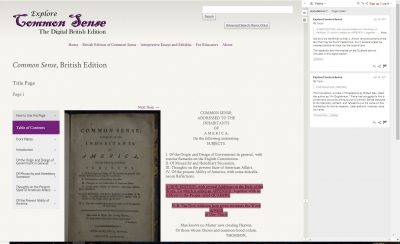Crossing the line: Facilitating digital access to primary sources
05 April 2018 – Kate Johnson and Marie Pellissier

ExploreCommonSense.com, a digital critical edition of Thomas Paine’s historic pamphlet and one of the digital projects represented in the working group. Image credit: Explore Common Sense.
Our working group, “Crossing the Line: Facilitating Digital Access to Primary Sources,” started with a simple premise. If, as Sheila Brennan states, digital humanities projects are not “public” projects merely by virtue of their being accessible online, how then can we craft them so as to place public engagement at the center? Is it even practical or achievable to do so? How will we know if we’ve done it? Among our nine participants and two facilitators, whose backgrounds and experiences cover a wide-range of digital projects at libraries, archives, universities, and museums throughout the United States, we’ve enjoyed unpacking these questions and more as we work to create a best-practices resource for public-facing digital archival projects.
In our first round of discussion we determined digital projects inherently serve multiple “publics,” including scholars, college and K-12 students, researchers, genealogists, hobby historians, and others. We simplified these various groups into two overarching categories: users and audiences. Rosalind Beiler gave us a working definition for these categories, with audiences as more passive consumers and users as engaged and interacting with the project, though as Adina Langer reminded us, these terms should be treated as a spectrum rather than two definitive camps. In discussing the needs of users and audiences, we explored utilizing community partners, looking to popular apps and sites for insight into user satisfaction, identifying our target audiences, and recognizing not all elements of a project need appeal to all users or audience members.
From there, Jay Wyatt challenged the group with the idea that public digital projects must meet certain benchmarks, including in areas of accessibility, having mechanisms for engagement, and being able to articulate clear success metrics. Join us in our online discussion here, as we discuss whether such benchmarks are achievable across diverse projects, and as we continue to debate users and audience, the ways in which digital projects can highlight silences in the record, and other related topics. We invite anyone interested in the conversation to comment.
We also welcome all who are working on, or interested in, digital humanities projects and public engagement to join us at NCPH 2018 for our in-person discussion and the creation of our best-practices resource. Our session will be on Saturday, April 21 from 10:30 a.m. – 12:30 p.m.
~ Kate Johnson and Marie Pellissier are graduate students at Loyola University Chicago and are co-facilitators of the “Crossing the Line” working group. Along with working group discussant Kelly Schmidt, they are co-creators of ExploreCommonSense.com, a digital critical edition of the first British printing of Thomas Paine’s pamphlet “Common Sense.”



